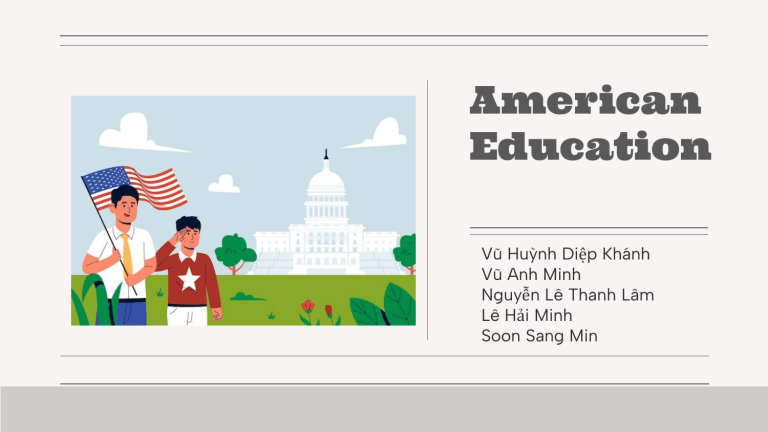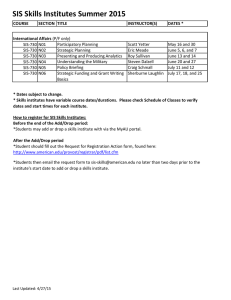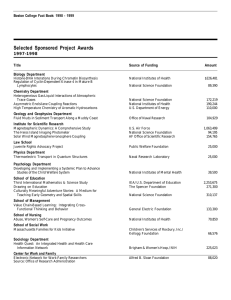
American Education Vũ Huỳnh Diệp Khánh Vũ Anh Minh Nguyễn Lê Thanh Lâm Lê Hải Minh Soon Sang Min Contents American Education System Guiding ideas Social Forces Affecting American Education Issues Facing American Schools Advantages and disadvantages 01/ American Educational System School: K-12 system Levels of Study of the U.S. Higher Education System UNDERGRADUATE (Age18-22) - Takes typically 4 years The American education system is very flexible Levels of Study of the U.S. Higher Education System GRADUATE IN PURSUIT OF A MASTER’S DEGREE (Age 22+) - requirements: bachelor’s degree Takes around 2 years mandatory for higher-level positions in library science, engineering, behavioral health, and education. Levels of Study of the U.S. Higher Education System GRADUATE IN PURSUIT OF A DOCTORATE’S DEGREE (Ph.D.) - requirements: master’s degree Takes around 3 years Types of educational institutes in the U.S ● Private colleges or universities ● Community colleges ● Public institutes- State College or ● University Institute of Technology Types of educational institutes in the U.S Private colleges or universities - Higher tuition fee than state-regulated college or university. Better staff-to-student ratio Higher amount of resources. Smaller in size Types of educational institutes in the U.S Private colleges or universities Types of educational institutes in the U.S Community colleges - Offers two-year programs with certificate course or associate degree. Types of educational institutes in the U.S Public Institutes - Regulated by the State government Affordable tuition fee Types of educational institutes in the U.S Institutes of Technology - offer a four-year degree in science and technology. Types of educational institutes in the U.S Private colleges or universities 02/ Guiding ideals 1. Wide access to education ● ● ● In the U.S, as many people as possible should have access to as much education as possible. It has no standardized examinations. the American system tries to help students 1. Wide access to education ● ● an outcome of Americans’ assumptions about equality among people. It doesn’t mean: everyone can enter Harvard, Stanford, or higher postsecondary institutions. 2. Universal Literacy ● ● U.S. educational system wants to produce a society that is 100 percent literate All American states have compulsory attendance laws that require young people to attend school until a specified age 3. Equal opportunity ● The U.S educational system aims to provide comparable educational programs to everyone 4. Local control ● ● ● ● The United States has no national ministry of education. State departments of education have some influence over the curriculum of primary and secondary schools Each school district has a separate board of education, usually elected by the public. Each state has many, many school districts. 5. Parental involvement ● Many primary and secondary schools idealize parental involvement in children’s education 5. Analysis and synthesis ● ● The assumption is that only a certain part of all that is potentially knowable is already known. The ideal educational situation is, therefore, one in which students are learning the skills of analysis and synthesis and are applying those skills to the process of discovering new knowledge. 5. Well-rounded people ● The American educational system wants to make its people “well-rounded”: + have specialized knowledge + acquainted with many discipline. + understand information from many fields of study. + participating in non-academic “extracurricular” activities. • “Well-rounded” people are more attractive to colleges and employers 6. Anti-intellectualizing ● ● ● Practical results are important. High-valued preprofessional fields of study: engineer, computer science, business —> leading to high-paying jobs. Low-value preprofessional fields of study: literature, philosophy, history, art —> “waste of time” 03/ Social Forces Affecting American Education “This is a quote, words full of wisdom that someone important said and can make the reader get inspired.” —Someone Famous 1. Social status of people involved in education Teachers Do not hold high status in the society. 1. Social status of people involved in education Teachers There has been a considerable increase in status of teachers in American society over the past few decades. 1. Social status of people involved in education Teachers • In 1982 In 2000 28% of respondents considered teaching was an occupation with great prestige. • • 53% of respondents considered teaching was an occupation with great prestige. Teachers were placed third on a list of 17 professions, below doctors and scientists. 1. Social status of people involved in education Professors • • Do not hold high status in the society except those who have practical contribution to science. Viewed as people who teach. Eliot Spitzer Political Science, City College of New York Temple Grandin Animal Science, Colorado State University 1. Social status of people involved in education Students •• Do not enjoy any great deal of respect. Being students is common. 2. The amount of money devoted to its support • Education competes with other public enterprises that need money. • States don’t consistently prioritize education. These charts illustrate the way U.S States Michigan and Florida spent their money in 2021. 3. Politics • In some states and communities, contemporary political conflicts are directly reflected in the administration of educational institutions 3. Politics • In some states and communities, contemporary political conflicts are directly reflected in the administration of educational institutions political supporters state governors 3. Politics • National political conflicts rarely have a direct influence on the staffing, governance, or policies of American educational institutions. 04/ Issues Facing American Schools Like all other social institutions, educational institutions are the subject of continuing controversy about one issue or another. 1. Financial support 2. Assessing the quality 2. Assessing the quality Some other controversial issues: Should children be allowed to pray at school? Should famous novels with “adult” and violence scenes be allowed at school library? Should religious symbol be used at national holidays at school? Some other controversial issues: What should students be taught about the origin of humankind? Are the facilities and opportunities allocated equally between poor school districts and richer ones? What can be done to help non-English speaking students? Some other controversial issues: What is the balance between general education and specialzed education? Are the facilities and opportunities allocated equally between poor school districts and richer ones? What are the proper supports for student with special needs? 05/ Advantages and Disadvantages From what has been said before, many of the American educational system’s advantages and disadvantages become clear Advantages • The system provides formal education for a relatively large portion of the population. Disadvantages • The quality of that education is not as high as it might be in a more selective system. Advantages • The system’s decentralization serves to insulate educational institutions from national political entanglements and to give citizens some voice in what happens in their local schools. Disadvantages • This decentralization makes it relatively easy for an outspoken and committed minority in a given community to embroil local schools in controversy and also makes it possible for particular schools to maintain low standards. Advantages • Well-rounded people from the American educational system tend to become “good citizen” Disadvantages • Those people may not be so well equipped to begin working in specific occupations Conclusion Like all other social institutions, educational institutions are the subject of continuing controversy about one issue or another.




